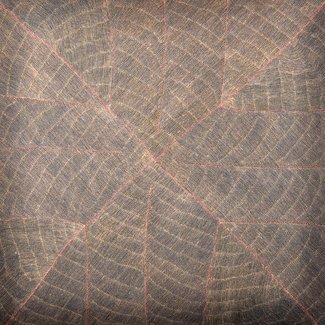Waterhouse art prize won by Aboriginal artist

MARGARET LOY PULA’S painting Anatye, which won her the overall prize in the Waterhouse Natural History Art Competition – Australia’s richest competition of its kind – illustrates an ancient dreaming story about the process of collecting bush potato vines using a very fine dot-painting technique.
In ancient times the women would go out hunting and dig underground for bush potatoes, a type of yam sometimes found up to a metre under the surface. These were then cooked up on hot coals much in the same way as they are today. Modern indigenous women, however, often make use of crowbars for the tough, dry digging work.
“When there’s been long periods of rain… we have to dig down maybe 30-40cm,” says Margaret. “If there’s been very little rain we might have to dig down a metre and the yams are quite small, which means we have to dig for more.”
Indigenous art is in the blood
Hailing from the Utopia community of the Northern Territory, Margaret comes from an acclaimed artistic family. Her mother is well-known artist Kathleen Petyarre and her aunties are the Petyarre sisters, whose artwork hangs in collections both in Australia and overseas.
“It’s just a beautiful and engaging painting,” says Mark Judd, head of Public Programs at the South Australian Museum. “Because this is such a strong example of a painting from Utopia the judges thought it was deserving of the overall winner.”
Although Margaret is the first Aboriginal artist to take the top award, other Aboriginal people have placed highly in other categories.
“We’ve had other Aboriginal people who’ve been finalists and we’ve had paintings that have won first prize and we’ve also had sculptural pieces which have won first prize in those particular sections,” says Mark. “But this is the first time we’ve had an overall winner [who] has won the big $50,000 prize.”
Winning the Australian art prize of prizes
This year was the 10th anniversary of the Waterhouse Art Prize and 840 pieces of art were submitted, the highest number received since the prize began.
The Waterhouse Natural History Prize is Australia’s richest prize for natural history art and boasts a prize pool of more than $110,000.
Internationally recognised, the contest has numerous pieces are entered from overseas each year. “In the lifespan of the prize about 30 countries have been covered,” said Mark. “The UK, China, Japan, Russia, also India, Turkey and Ecuador even. If you looked at a map it would be dotted all over the globe.”
Margaret’s piece will eventually go into the Waterhouse Art Prize Collection in the South Australian Museum. Before that the winning and highly commended artworks will travel from an exhibit at the South Australian Museum to the National Archives of Australia, Canberra, in September.

The winning entry, Anatye. (Credit: Muk Muk Fine Art)
RELATED STORIES




